Growing hops from seed
Tuesday, March 12th, 2013
Note: this is from 2013. You might also be interested in the 2014 breeding, 2015 breeding…
Oregon is an optimal place to grow hops. They take up a lot of space, but are very gratifying and economical to grow. At the local homebrew store, hops will run $2-3 per ounce. Last year, with 7 mature plants, I ended netting about 10 lbs of dried hops.
Different varieties?
Some of the varieties in my yard are quite common: Sterling, Mt. Hood, Willamette, Cascade, Nugget, Chinook, Newport, Galena
Some are a little more rare: Pride of Ringwood (from Australia), Teamaker (super-low bitterness)
Interestingly, there are a limited number of varieties – less than 50 – that are available to the hobbyist grower. This is due to the fact that hops are traditionally grown from a rhizome (root) cutting. The propagation method means that my Cascade plant is genetically the same as your Cascade plant – they are essentially clones.
Since hops propagate so easily through cloning, the genetics have never been stabilized. They will not grow true from seed. If you were able to pollinate my Cascade plant, the offspring would not be Cascade. In fact, each seed would produce a slightly different plant. Growing a hop plant from seed would be a genetic lottery… Unfortunately, it’s difficult to play this lottery: Hop pollen and male plants are not readily available.
Obtaining seeds
You cannot get seeds from known varieties. You can get seeds for ornamental hops online – but, I was interested in starting with something a little more genetically interesting.
Thanks to friends and acquaintances online, I was able to score seeds from several wild plants growing around North America. These plants were either:
- Escaped from commercial growing operations (life finds a way :)
- Or, native/wild to this continent: Humulus lupulus neomexicanus
These particular seeds were sourced from: Wyoming, Colorado and Saskatchewan, Canada.
Sprouting the seeds
Hop seeds proved more difficult to sprout than I expected. They require a cold stratification period of dormancy, Here are some basic steps that I followed:
- Soak the seeds in a slight bleach solution to sterilize the surface.
- Place the seeds ziplock with a barely wet (wrung out) paper towel.
- Store at 40F in the fridge for a month.
- After a month, move the seeds to a +70F area.
- As they individually sprout, move the seeds to soil
At this point only a few of the seeds have sprouted. If, after a few weeks, there is no sign of further activity, I plan to repeat steps 2-4.
Propagation activity log
- 2013-02-01: Began cold stratification 40F
- 2013-03-01: Moved to 70F
- Sprouts: Wyoming 001, 002
- 2013-03-20: Alternative method. Seeds soaked for 48hours @Â 40F, then seed coat removed
- 2013-03-25: Seed coats removed from original, stratified seeds:
- Sprouts:Â Colorado 001, 002
| ID | Seed | Sprout | 1st true leaves | 2nd leaves | Potted | Sex? |
|---|---|---|---|---|---|---|
| NHB001 | Wyoming 001 | 2013-03-02 | 2013-03-10 | 2013-03-20 | 2013-03-25 | Male |
| NHB002 | Wyoming 002 | 2013-03-11 | 2013-03-19 | 2013-04-01 | 2013-04-05 | Male |
| NHB003 | Colorado 001 | 2013-03-30 | 2013-04-05 | 2013-04-14 | 2013-05-01 | Female |
| ? |
Update 2013-05-30:
Only three of the starts are thriving.
- The Colorado is still in the greenhouse, but is about ready to pot up and move outside.
- Both of the Wyoming are in large pots outside. One is over 5′ tall and putting out laterals.
- There also seem to be small, male flower buds forming on the Wyoming 001 – We may have a boy!
- Wild hops mother plant, Wyoming
- Seed sprout, Wyoming
- True leaves, Wyoming
- Second set of leaves!
- Ready to go outside
- It’s a boy!
Update 2013-09-25:
The three pants grew well throughout the season. Unfortunatly, the male flowers we spotted never matured. However, the Colorado developed dozens of nice cones:
Update 2014-06-04:
This spring all three plants were moved to the hop yard that we set up for the new seedlings. Of course, these ones are a year ahead and have really taken off. No cones yet, but the different morphology of the leaves is striking.
On the left is Colorado 001. On the right is Wyoming 001.

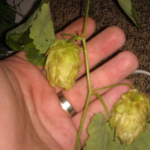
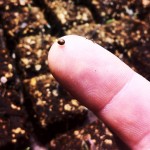
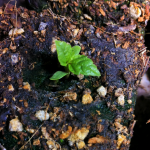
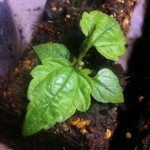
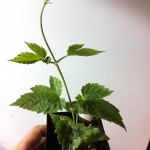
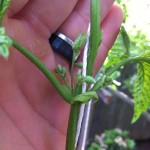

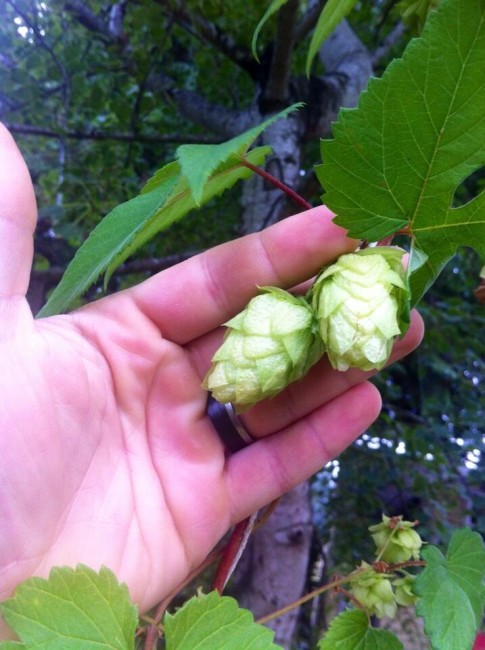
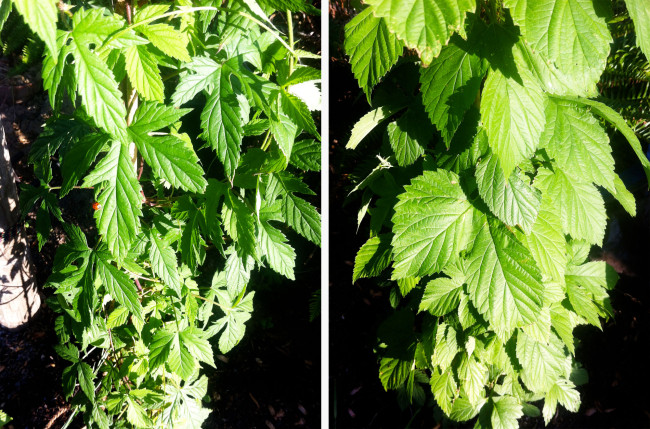
Growing hops from seed - Home Brew Forums Says:
[…] the first plant to sprout (Wyoming) produced a set of true leaves. Feel free to follow along: http://gabriel.nagmay.com/2013/03/hops-from-seed/ I would also appreciate any advice/resources that you might have. Cheers, Nagmay […]
cones and seeds on 1 plant - Page 2 - Home Brew Forums Says:
[…] a better idea: Can I persuade you to send me the seeds? I am conducting a hobby breeding program: http://gabriel.nagmay.com/2013/03/hops-from-seed/ In return, I would be happy to share any plants once they are established. Thanks, Nagmay […]
Shipping Wild Rhizomes (and sexing them) - Home Brew Forums Says:
[…] you do find any wild males, please let me know. I am trying my hand at breeding: http://gabriel.nagmay.com/2013/03/hops-from-seed/ Would be happy to send you some female starts in […]
hop seeds - Home Brew Forums Says:
[…] "it's not too far fetched that you could potentially end up with something MORE appealing that Amarillo." That might be true if the parents were brewing hops. These ebay listings are scams. If you even get hop seeds, they will most likely be ornamental hops… since large quantities of those seeds are readily available. While they technically can be use for brewing/breeding, ornamental hops are not going to ever be the next Amarillo. "has anyone had any experience" I do have experience starting wild hops fro seed. It's difficult, but can be done: http://gabriel.nagmay.com/2013/03/hops-from-seed/ […]
Shaun Says:
Do you know where I can get a variety types of hop seeds online?
nagmay Says:
Shaun,
Short answer: You can’t.
More: Hops don’t grow true from seed. Anyone selling seeds for a particular variety are either setting up a scam, or they simply don’t understand hop genetics.
You can get “ornamental” hop seeds from ebay, amazon and various seed companies online.
While they technically can be use for brewing/breeding, the acid levels and aroma qualities are going to be a crap shoot.
Yes, this is also true for the wild hops I am starting with – however, since not a lot of breeding has been done with wild hops, I hope to explore the genetic possibilities.
josh Says:
The best beer i ever had was brewed using wild american hops. Just amazing. The wild hops have some diversity and some are better than others, but many modern brewing hops owe their best qualities to alleles from the wild hops.
Josh Says:
Good morning Gabriel,
I am interested in what you currently have going on and would like to help if possible. I myself am interested in hop genetics and am waiting to sex several plants, but am interested in beginning others from seed. Please feel free to e-mail/contact me so we can talk further.
Best,
Josh
gabriel nagmay (dot com) | Archive Says:
[…] is a continuation of the hop breeding experiments that I first wrote about in 2013. If you are wondering why someone would bother growing hops from seed – go check out that […]
gabriel nagmay (dot com) | Archive » Hop Breeding (2014) Says:
[…] is a continuation of the hop breeding experiments that I first wrote about in 2013. If you are wondering why someone would bother growing hops from seed – go check out that […]
Eddie Spohn Says:
Hi Gabriel. Just a quick thought on growing hops from seed. If you grow out some plants and happen upon an individual with desirable qualities, would clones from that plant be considered a new ‘variety’?
nagmay Says:
Eddie,
Exactly. Due to the fact that hops haven’t been inbred to the point of stability, any cross grow from seed would be a new variety. The question, as you point out, is if the new hops has desirable qualities.
gabriel nagmay (dot com) | Archive » Hop Breeding, 2014 Results Says:
[…] may want to start by reading: Growing hops from seed, Hop Breeding […]
Travis Says:
Greetings,
Out in Colorado scouting native hops populations currently. Would like to collab and get a couple cuttings/seeds from you if possible. Give me a shout.
Thanks,
Travis
gabriel nagmay (dot com) | Archive » Hop Breeding (2015) Says:
[…] may want to start by reading: Growing hops from seed, Hop Breeding (2014), Breeding results […]
Robert Says:
I’m interested in growing from seed rather than rhizome, do you know of anywhere on the west coast I can buy seeds?
nagmay Says:
Are you interested in breeding new hops? That is really the only reason to grow from seed. It is also why seeds are so hard to find.
gabriel nagmay (dot com) | Archive » Hop Breeding (2016) Says:
[…] may want to start by reading: Growing hops from seed, Hop Breeding (2014), Breeding results 2014, Hop Breeding […]
Yanick Gil Says:
Hi, I write from México, un the yucatan peninsula.
I am cultivating hops successfully, with high temperatures and against odds. muy sources to acquire the material are vendors of seeds in internet,because rizomas i can
Yanick Gil Says:
I can not get here. I get seeds from varios places forma get higher diversity.Im having a good crop in spite of high temperaturas (today 44°c
Yanick Gil Says:
so somehow I am an enthusiast of crop genetic diversely. to stimulate flowering por awakening lethargy I use fitohormonas un plants. using this technique I can also get violets in bloom all year. I am convinced to be able to achieve my objective.
muy question is about how I can get some seeds of neomexicanus hops because what I have read this species is very heat tolerant.perfect for my proyect.please if you know of any place or if you have some to sell por exchange please consider me. thanks forma your time. I wait for news.
nagmay Says:
Yanick,
I’m impressed that you can cultivate hops in those temps!
In 2002 the USDA collected neomexicanus seeds from Colorado and New Mexico. There is actually a full report online: http://www.ars-grin.gov/cor/reprints/hopexpedition2002.pdf and if you look each up in their database, they show the exact GPS location. If you know someone in those areas, they may be able to collect some seeds.
That said, I am not convinced that neomexicanus are any better suited for hot weather. Most of the specimens were collected at high elevations…
Best luck,
Gabriel
yanick Says:
Hi thanks forma the hint.
I think it is an advantage of seed plants to better adapt. but also it helps a little acetylsalicylic acid also to lower stress un plants (it is not a joke).
I hace just one more question: which is the best time of the year to collect seeds in USA?
thanks.
nagmay Says:
Yanick,
September would be the best time to collect wild seed. Looks like the 2002 USDA expedition was from Sept 9 – 20.
Keep me updated. I would love to see some pictures of your setup. My email is gabriel@nagmay.com
Sébastien Says:
Hi!
Any chance to buy seeds / plants from you? I’d be happy to try a similar experience as yours, but wild hops are not common here in Switzerland…
gabriel nagmay (dot com) | Archive » Hop Breeding, 2016 Results Says:
[…] may want to start by reading: Growing hops from seed, Hop Breeding (2014), Hop Results […]
gabriel nagmay (dot com) | Archive » Hop Breeding, 2017 Says:
[…] may want to start by reading: Growing hops from seed, Hop Breeding, Hop Results […]
gabriel nagmay (dot com) | Archive » Wild hops in the United States Says:
[…] you may have noticed, I am a bit … obsessed … about hops. So, I was stoked when Michael contacted me in the comments […]
gary Says:
can you please spare some hop beans…….gump . gary thornton 21504 coyote trail ,lago vista texas 78645
Hossein Lotfalizadeh Says:
Hi dear friend,
I saw you interesting works on hop.
We have a team of researchers who work on hop in Iran in Iran. We started to improve its culture in the northwest of Iran.
Do you have any experience with variety that distributed in this area?
My second question is that do you have any idea about percent of male versus female in the obtained plants from sprouting the seeds?
Best regards
Hossein
nagmay Says:
Hossein Lotfalizadeh,
Sounds like a great project. I wish you the best of luck. Unfortunately, I do not have any experience with hops from that part of the world. All my stock comes from the US and older European varieties.
From my experience the male/female ratio for hops sprouted from seed is close to 50/50.
Thanks,
Gabriel
Brandon Says:
Love your project man keep up the great work! I’ve been recently getting into studying humunlus as well. I’m trying to germinate some Chmiel Japonski, H.Japonicus that has acclimated to Poland. I’m following your guide on germination & stratification, hoping I can get these seeds to germ utilizing the same methods. Thank you!
Ian Daitz Says:
I succeeded in rowing NM wild hops from seed this year. I live in NM and have access to wild seed. I don’t know anything about sexing them other than following protocol established for cannabis. I am not sure if the internodes are good indicators as they are with their cannabis cousins.
gabriel L Nagmay Says:
Ian,
In my experience, hops are a bit harder to sex. You usually need to wait until they start to present flowers. Female cones start as fuzzy burs covered with white hair like glands. Male flowers start as clusters of pods.
Would love to see some pictures of what you are growing.
-gabriel
George F Says:
Ian Dailtz – I am in NM also, learning about native hops and growing it on axlecanyon preserve at 6,000′ near Silver City. Where did you obtain your native seeds? Thanks, g
gabriel Says:
George,
Most of my neo seeds were collected by people living near the areas listed in the 200 USDA report mentioned above. Various seeds came from states ranging from Arizona to Colorado.